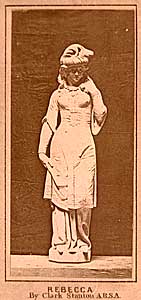 |
Rebecca
Found on the lower tier of the south-east buttress of the Scott
Monument.
The statue of Rebecca, the Jewess (from the novel 'Ivanhoe',
1819), is shown in a graceful attitude, toying with her long hair
as when she attracted the attention of Prince John at the tournament
of Ashby.
The daughter of Isaac of York, she and her father are subjected
to much abuse by both Saxons and Normans because they are Jews.
"Her form was exquisitely symmetrical, and was shown
to advantage by a sort of Eastern dress, which she wore according
to the fashion of the females of her nation. Her turban of yellow
silk suited well with the darkness of her complexion. The brilliancy
of her eyes, the superb arch of her eyebrows, her well-formed aquiline
nose, her teeth as white as pearl, and the profusion of her sable
tresses - all these constituted a combination of loveliness, which
yielded not to the most beautiful of the maidens who surrounded
her."
Courageous but humble, she thinks it the duty of the children of
Zion to "suffer without sinning". She falls in love with
Ivanhoe when nursing his wounds, and he in due course saves her
from sentence of death for witchcraft, by acting as her champion.
Ivanhoe, however, loves and is united
with the Saxon Lady Rowena, and Rebecca leaves England with her
father.
About the Sculptor
Clark Stanton (1832 to 1894)
George Clark Stanton was born in Birmingham in 1832 and died in
Edinburgh on the 8th January 1894. He was educated at King Edward’s
Grammar School and Birmingham School of Art, where he studied silversmithing. He was also a painter of portraits, portrait miniatures and rustic
subjects, often on a romantic, literary and historical theme.
“His heroines wore richly coloured dresses and
his backgrounds are finely detailed, yet his pictures carry great
conviction and never appear like theatrical charades”.
While working for Elkington & Mason he was sent to Florence
to study Renaissance sculpture and metalwork. In 1855 he settled
in Edinburgh and lived at 1 Ramsay Lane, but sold very few artworks
during his life and was continuously in debt. He was elected ARSA
(Associate of the Royal Scottish Academy) in 1862 and RSA in 1885.
Other works include bronze panels on the Buccleuch Memorial on
the Royal Mile and statues of ‘Army and Navy’ on the
Albert Memorial in Charlotte Square.
Other figures on the Scott Monument are Friar Tuck and Sir Piercie
Shafton.
^ back to the top |



